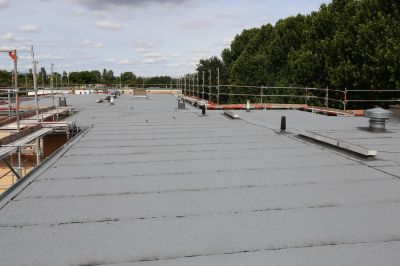Top Products For Roof Repitchings To Enhance Structural Integrity
Explore the leading tools and materials essential for effective roof repitching projects that improve durability and performance.
 Roof repitching is an essential process for homeowners and contractors seeking to modify the angle or slope of a roof to improve drainage, accommodate new architectural designs, or address structural issues. This task involves carefully removing existing roofing materials, adjusting the underlying framing, and installing new components to achieve the desired pitch. The process requires a combination of specialized tools and materials to ensure safety, durability, and proper functionality.
Roof repitching is an essential process for homeowners and contractors seeking to modify the angle or slope of a roof to improve drainage, accommodate new architectural designs, or address structural issues. This task involves carefully removing existing roofing materials, adjusting the underlying framing, and installing new components to achieve the desired pitch. The process requires a combination of specialized tools and materials to ensure safety, durability, and proper functionality.
Top Overall Option
Adjustable Roof Rafter System
An adjustable roof rafter system offers versatility for modifying roof pitches with precision. Designed to accommodate a range of angles, these systems often include components like adjustable brackets, reinforced rafters, and compatible fasteners. They enable contractors and DIY enthusiasts to customize the pitch while maintaining structural integrity, making them a popular choice for various repitching projects.
Types of Products For Roof Repitchings
Roof Framing Lumber
High-quality framing lumber provides the foundational support needed to alter roof slopes safely and effectively.
Adjustable Rafter Brackets
These brackets allow for flexible angle adjustments during roof repitching, ensuring precise alignment.
Roof Underlayment
A durable underlayment offers moisture protection beneath the roofing materials, especially important during structural modifications.
Metal Flashing
Metal flashing helps seal joints and transitions, preventing water intrusion after repitching.
Roofing Nails and Fasteners
Specialized nails and fasteners ensure secure attachment of roofing components during and after the repitch process.
Roof Sealants and Adhesives
Sealants provide weatherproofing and help secure roofing materials in place, especially at seams and edges.
Roofing Felt Paper
Felt paper adds an additional layer of moisture barrier beneath the final roofing material.
Structural Support Beams
Support beams reinforce the roof structure when significant pitch adjustments are made.
Roofing Screws
Heavy-duty screws secure roofing panels and components firmly in place.
Roof Ventilation Components
Proper ventilation ensures airflow and reduces moisture buildup after repitching.
Roof Ladder and Safety Gear
Essential safety equipment for secure access and safe working conditions during roof modifications.
Roofing Templates and Guides
Templates assist in achieving accurate angles and measurements during the repitch process.
Roof Edge Metal
Edge metal protects roof edges and enhances durability after reconfiguration.
Roofing Insulation
Insulation can be added or adjusted to improve energy efficiency following a roof pitch change.
Popular Choices
Adjustable rafters are trending for their flexibility in modifying roof slopes with ease.
Complete fastener kits are favored for their convenience in securing roofing materials during repitching.
Sealants that provide reliable weatherproofing are commonly used in roof modifications.
Flexible metal flashing rolls are popular for sealing joints and transitions after repitching.
Durable underlayment rolls are frequently chosen for added moisture protection beneath new roofing layers.
High-quality safety harnesses are essential for secure work at heights during roof projects.
Corrosion-resistant roofing nails are widely used for attaching materials securely.
Ventilation fans are trending for maintaining airflow and reducing moisture issues.
Templates assist in achieving accurate cuts and measurements for custom roof angles.
Support beams are frequently used to reinforce structural integrity after pitch adjustments.
Edge metal products are popular for finishing and protecting roof edges post-reconfiguration.
Insulation boards are commonly added to improve energy efficiency following roof modifications.
One of the fundamental considerations when undertaking a roof repitch is selecting the appropriate materials that can withstand environmental stresses and integrate seamlessly with existing structures. Proper planning and precise execution are critical to prevent leaks, ensure stability, and extend the lifespan of the roof. Whether the project involves minor adjustments or a complete overhaul, having the right products on hand can streamline the process and contribute to a successful outcome.
In addition to structural components, various accessories and supplementary products are often necessary to complete a repitch effectively. These include underlayment, flashing, fasteners, and specialized sealants designed to provide weatherproofing and secure attachment. The selection of these products should be based on compatibility with the existing roof materials and the specific requirements of the new pitch.
Safety is paramount during roof repitching projects. Using high-quality safety harnesses, scaffolding, and protective gear ensures that workers can perform their tasks securely at heights. Proper planning and adherence to safety standards help minimize risks and facilitate a smooth workflow throughout the project.
Key Buying Considerations
- Compatibility with existing roof materials and structure
- Strength and durability to withstand environmental conditions
- Ease of installation for both DIY and professional projects
- Adjustability features for precise pitch modifications
- Weatherproofing capabilities of sealants and underlayment
- Compatibility of fasteners and hardware with roofing materials
- Safety features and compliance with safety standards
- Availability of different sizes and lengths to suit project needs
- Corrosion resistance for longevity in various climates
- Flexibility of materials to accommodate design changes
- Cost-effectiveness relative to project scope
- Reputation and reviews of product quality
- Ease of handling and transportation
- Compatibility with insulation and ventilation systems
- Warranty or guarantee offered by manufacturers
